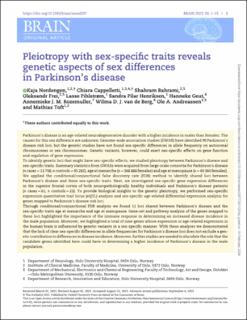Pleiotropy with sex-specific traits reveals genetic aspects of sex differences in Parkinson's disease
Nordengen, Kaja; Cappelletti, Chiara; Bahrami, Shahram; Frei, Oleksandr; Pihlstrøm, Lasse; Henriksen, Sandra Pilar; Geut, Hanneke; Rozemuller, Annemieke J M; Berg, Wilma D J van de; Andreassen, Ole; Toft, Mathias
Peer reviewed, Journal article
Published version
Date
2023Metadata
Show full item recordCollections
Abstract
Parkinson’s disease is an age-related neurodegenerative disorder with a higher incidence in males than females. The causes for this sex difference are unknown. Genome-wide association studies (GWAS) have identified 90 Parkinson’s disease risk loci, but the genetic studies have not found sex-specific differences in allele frequency on autosomal chromosomes or sex chromosomes. Genetic variants, however, could exert sex-specific effects on gene function and regulation of gene expression.
To identify genetic loci that might have sex-specific effects, we studied pleiotropy between Parkinson’s disease and sex-specific traits. Summary statistics from GWASs were acquired from large-scale consortia for Parkinson’s disease (n cases = 13 708; n controls = 95 282), age at menarche (n = 368 888 females) and age at menopause (n = 69 360 females). We applied the conditional/conjunctional false discovery rate (FDR) method to identify shared loci between Parkinson’s disease and these sex-specific traits. Next, we investigated sex-specific gene expression differences in the superior frontal cortex of both neuropathologically healthy individuals and Parkinson’s disease patients (n cases = 61; n controls = 23). To provide biological insights to the genetic pleiotropy, we performed sex-specific expression quantitative trait locus (eQTL) analysis and sex-specific age-related differential expression analysis for genes mapped to Parkinson’s disease risk loci.
Through conditional/conjunctional FDR analysis we found 11 loci shared between Parkinson’s disease and the sex-specific traits age at menarche and age at menopause. Gene-set and pathway analysis of the genes mapped to these loci highlighted the importance of the immune response in determining an increased disease incidence in the male population. Moreover, we highlighted a total of nine genes whose expression or age-related expression in the human brain is influenced by genetic variants in a sex-specific manner. With these analyses we demonstrated that the lack of clear sex-specific differences in allele frequencies for Parkinson’s disease loci does not exclude a gen- etic contribution to differences in disease incidence. Moreover, further studies are needed to elucidate the role that the candidate genes identified here could have in determining a higher incidence of Parkinson’s disease in the male population.
